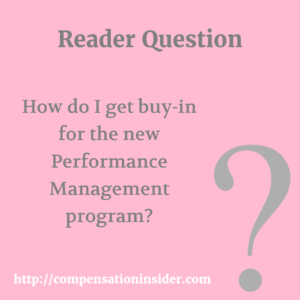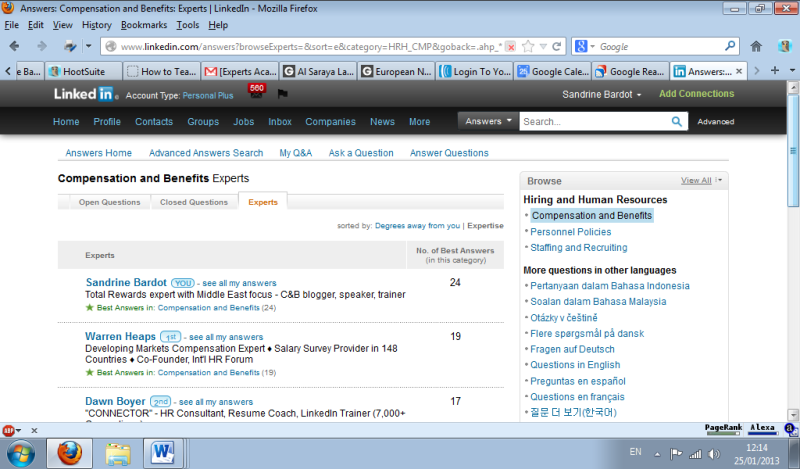I will mourn the retirement of LinkedIn Answers.
This was, for me, one of the most engaging features of LinkedIn, where anyone could ask questions and other members would volunteer to share their views and knowledge. The conversations in there were real, and often led to making new connections based on a common interest. I was quite active in the Compensation & Benefits section of Answers, and actually was rated best expert on the topic by the people who asked those questions, as you can see below.
Why am I telling you this ? One of my recent subscribers asked for advice on how to ensure that employees would accept the Performance Management system they are about to deploy at his company. This is actually a question that got me a “Best Answer” rating on LinkedIn Answers, so I thought I would share.
The LinkedIn member asked the following question :
“If I would like to gain a team’s acceptance and commitment towards the implementation of a new performance management program, what are some of the issues I have to take into account?”
There are a number of things you need to discuss with your team , if you want to get understanding and performance management buy-in :
Why it was introduced ie the reason(s) for the company to set it up, and how that translates into positive things for employees (the “what’s in it for me ?” factor is absolutely essential to get buy-in of the performance management program). Here you can talk about getting clearly defined objectives, opportunity for on-going feedback and official recognition of the good work etc. If your company has put these in place, you can also talk about the introduction or improvement of formalized, individual development plans, the chance to do a self-evaluation and officially show your best achievements, and how the process will link to pay for performance (increases or bonuses).
Explain line of sight, ie how the overall company strategy will cascade at each level of the organization, and how your team’s objectives will help achieve the company goals– and the way that each of your team members can influence this through their work.
Discuss what the performance ratings mean. If not done already by your company, you need to explain how each rating relates in terms of “what” (the achievement of the objectives), “how” (the behaviours sanctioned, or not, by the company) and its meaning in terms of adhering (or not) to company values.
Describe the process in terms of steps (what is done, when, by whom) so that people can anticipate potential workload on their side. Also describe which training will be provided to managers and employees, and what the transition phase will be for the implementation of this system.
You need to anticipate that you will get some anxious (and legitimate) questions, because this is new and people don’t like change.
You’ll have questions such as :
- “What happens if I get a bad rating ? Will I be terminated ?”,
- “What if my manager doesn’t like me and I don’t agree with my rating ?” (hopefully your company has put in place a process for managing disagreements),
- “What happens if the manager is new and doesn’t know me ?”,
- “How do we ensure that all managers are rating their teams in the same way ? We know that some of them are really nice and some of them are very strict”,
- “What happens if one project we agreed at the beginning of the year is then abandoned ? Or if there is a new project coming up, that we did not anticipate ? Or if we need to revise the level of one target during the year because of the economy ?” etc.
Be ready to answer those, and if you don’t know the answer, say you will follow-up – and do it. Follow-up with the whole team not just the person who asked the question (it can be a quick informal debrief, or at the next team meeting if not too late in time, or through email – but don’t skip it).
And for the team to really engage, you will need to hold regular conversations on the topic, at least as each step is coming up, reinforcing the message. Maybe organize a debrief after the first full cycle is done, to get your team’s feedback on what works well and what doesn’t. You need to be open to the fact that they might give you suggestions on things you can improve (for example, how frequently and how well you give feedback).
In the end, what truly matters is that you are leading by example. Demonstrate your interest and commitment to the process, make it a living one (give feedback regularly, review objectives if needed…), and your people will eventually follow. Once management actually lives and breathes a permanent, continuous approach to managing performance, the tool, system and evaluation at the end of the cycle all become a simple formality that no-one fears or resent as they are a simple continuation of the on-going performance dialogue between the employee and manager.
So LinkedIn Answers are dead – but I want to use this blog to continue to try and help others, so please don’t hesitate to send me your questions – if I can, I will write a post about it and hopefully others will find it beneficial too.
Related posts :





Speak Your Mind